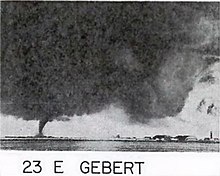 An image of the F5 tornado as it neared Hector International Airport. | |
| Meteorological history | |
|---|---|
| Formed | June 20, 1957 4:40 p.m. CDT (UTC−06:00) |
| Dissipated | June 20, 1957 8:10 p.m. CDT (UTC−06:00) |
| Duration | 3 hours, 30 minutes[1] |
| F5 tornado | |
| on the Fujita scale | |
| Highest winds | 275 mph (442.57 km/h) |
| Overall effects | |
| Fatalities | 10-12 |
| Injuries | 103 |
| Damage | $25.250 million (1957 USD) $281 million (2024 USD) |
| Areas affected | Cass County, North Dakota, especially Fargo, and Clay County, Minnesota, especially Moorhead |
Part of the 'tornado outbreaks of 1957 and the Tornado outbreak sequence of June 20–23, 1957' | |
On June 20, 1957, a violent and deadly F5 tornado struck the north side of Fargo, North Dakota[1] as well as the area north of Moorhead, Minnesota. It was part of a family of five devastating tornadoes produced by one supercell over the course of 3.5 hours, although they are listed as one continuous tornado. The tornado family started in North Dakota, traveled 27.4 miles (44.1 km) to the Minnesota border before crossing it and continuing for another 25 miles (40 km) for a total track length of 52.4 miles (84.3 km). Additionally, at its widest point, the damage swath reached 500 yards (460 m) across. A total of 10 people (some sources say 12) were killed, making it the deadliest tornado in North Dakota history. Meanwhile, 103 others were injured, and damage was estimated at $25.25 million (1957 USD). It was part of a larger outbreak sequence of 23 tornadoes that affected the Midwest and Great Plains.
- ^ a b "A Detailed Analysis of the Fargo Tornadoes of June 20, 1957" (PDF). Forecasts.weather.gov. Archived from the original (PDF) on March 4, 2016. Retrieved April 9, 2015.